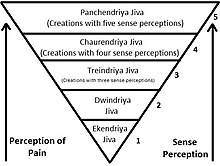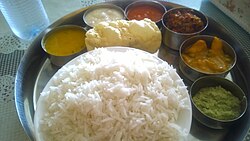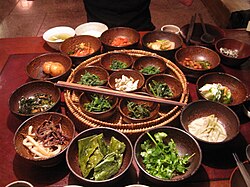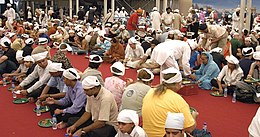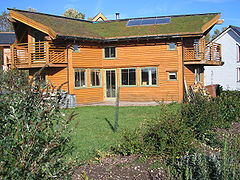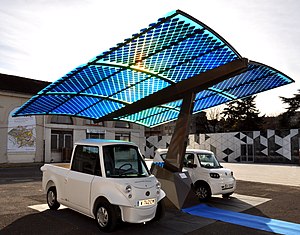A vegetarian thali from Rajasthan, India. Since many Indian religions promote vegetarianism, Indian cuisine offers a wide variety of vegetarian delicacies
Vegetarianism is strongly linked with a number of religions that originated in ancient India (Hinduism, Jainism and Buddhism). In Jainism, vegetarianism is mandatory for everyone; in Hinduism and Mahayana Buddhism, it is advocated by some influential scriptures and religious authorities. Comparatively, in the Abrahamic religions (Judaism, Christianity, and Islam), the Bahá'í Faith and Dharmic religions such as Sikhism,
vegetarianism is less commonly viewed as a religious obligation,
although in all these faiths there are groups actively promoting
vegetarianism on religious grounds.
Indian religions
Vegetarianism in ancient IndiaIndia is a strange country. People do not kill—Faxian, 4th/5th century CE
any living creatures, do not keep pigs and fowl,
and do not sell live cattle.
Chinese pilgrim to India
Most Indian religions have philosophical schools that forbid consumption of meat and Jainism institutes an outright ban on the same. Consequently, India is home to more vegetarians than any other country. About 30% of India's 1.2 billion population practices lacto vegetarianism, with overall meat consumption increasing.
The per capita meat consumption in India in 2002 was 5.2 kg, while it
was 24 times more in the United States at 124.8 kg. Meat consumption in
the United States and India grew at about 40% over the last 50 years. In
1961 Indian per capita meat consumption was 3.7 kg, while the US
consumption was 89.2 kg.
Jainism
The food choices of Jains are based on the value of Ahimsa (non-violence), and this makes the Jains to prefer food that inflict the least amount of violence
Vegetarianism in Jainism is based on the principle of nonviolence (ahimsa, literally "non-injuring"). Vegetarianism is considered mandatory for everyone. Jains are either lacto-vegetarians or vegans.
No use or consumption of products obtained from dead animals is
allowed. Moreover, Jains try to avoid unnecessary injury to plants and suksma jiva (Sanskrit for subtle life forms;
minuscule organisms). The goal is to cause as little violence to living
things as possible, hence they avoid eating roots, tubers such as
potatoes, garlic and anything that involves uprooting (and thus
eventually killing) a plant to obtain food.
Every act by which a person directly or indirectly supports killing or injury is seen as violence (hinsa), which creates harmful karma. The aim of ahimsa is to prevent the accumulation of such karma.
Jains consider nonviolence to be the most essential religious duty for
everyone (ahinsā paramo dharmaḥ, a statement often inscribed on Jain
temples). Their scrupulous and thorough way of applying nonviolence to
everyday activities, and especially to food, shapes their entire lives
and is the most significant hallmark of Jain identity. A side effect of
this strict discipline is the exercise of asceticism, which is strongly encouraged in Jainism for lay people as well as for monks and nuns.
Jains do not practice animal sacrifice as they consider all sentient beings to be equal.
Hinduism
Vegetarianism is an integral part of most schools of Hinduism although there are a wide variety of practices and beliefs that have changed over time. An estimated 30% of all Hindus are vegetarians. Some sects of Hindus do not observe vegetarianism.
Nonviolence
The principle of nonviolence (Ahimsa) applied to animals is connected with the intention to avoid negative karmic
influences which result from violence. The suffering of all beings is
believed to arise from craving and desire, conditioned by the karmic
effects of both animal and human action. The violence of slaughtering
animals for food, and its source in craving, reveal flesh eating as one
mode in which humans enslave themselves to suffering.
Hinduism holds that such influences affect the person who permits the
slaughter of an animal, the person who kills it, the person who cuts it
up, the person who buys or sells meat, the person who cooks it, the
person who serves it up, and the person who eats it. They must all be
considered the slayers of the animal. The question of religious duties towards the animals and of negative Karma incurred from violence (himsa) against them is discussed in detail in Hindu scriptures and religious law books.
Hindu scriptures belong or refer to the Vedic period which lasted till about 500 BCE according to the chronological division by modern historians. In the historical Vedic religion,
the predecessor of Hinduism, meat eating was not banned in principle,
but was restricted by specific rules. Several highly authoritative
scriptures bar violence against domestic animals except in the case of
ritual sacrifice. This view is clearly expressed in the Mahabharata (3.199.11-12; 13.115; 13.116.26; 13.148.17), the Bhagavata Purana (11.5.13-14), and the Chandogya Upanishad (8.15.1). For instance, many Hindus point to the Mahabharata's maxim that "Nonviolence is the highest duty and the highest teaching," as advocating a vegetarian diet. The Mahabharata
also states that adharma (sin) was born when creatures started to
devour one another from want of food and that adharma always destroys
every creature " It is also reflected in the Manu Smriti (5.27-44), a particularly renowned traditional Hindu law book (Dharmaśāstra). These texts strongly condemn the slaughter of animals and meat eating.
The Mahabharata (12.260;
13.115-116; 14.28) and the Manu Smriti (5.27-55) contain lengthy
discussions about the legitimacy of ritual slaughter and subsequent
consumption of the meat. In the Mahabharata both meat eaters and
vegetarians present various arguments to substantiate their viewpoints.
Apart from the debates about domestic animals, there is also a long
discourse by a hunter in defence of hunting and meat eating.
These texts show that both ritual slaughter and hunting were challenged
by advocates of universal non-violence and their acceptability was
doubtful and a matter of dispute.
Current situation
In
modern India the food habits of Hindus vary according to their
community or caste and according to regional traditions. Hindu
vegetarians usually eschew eggs but consume milk and dairy products, so they are lacto-vegetarians.
According to a survey of 2006, vegetarianism is weak in coastal
states and strong in landlocked northern and western states and among Brahmins in general, 55 percent of whom are vegetarians. In 2018, a study from Economic and Political Weekly shows that in facts only a third of the upper-caste Indians could be vegetarian.
Many coastal inhabitants are fish eaters. In particular Bengali Hindus have romanticized fishermen and the consumption of fish through poetry, literature and music.
Animal sacrifice in Hinduism
Animal sacrifice in Hinduism (sometimes known as Jhatka Bali) is the ritual killing of an animal in Hinduism.
The ritual sacrifice normally forms part of a festival to honour a Hindu god. For example, in Nepal the Hindu goddess Gadhimai, is honoured every 5 years with the slaughter of 250,000 animals. Bali sacrifice today is common at the Sakta shrines of the Goddess Kali. However, animal sacrifice is illegal in India.
Buddhism
Buddhist influenced Korean vegetarian side dishes.
The First Precept prohibits Buddhists from killing people or animals. The matter of whether this forbids Buddhists from eating meat has long been a matter of debate.
The first Buddhist monks and nuns were forbidden from growing,
storing, or cooking their own food. They relied entirely on the
generosity of alms to feed themselves, and were not allowed to accept
money to buy their own food. They could not make special dietary requests, and had to accept whatever food alms givers had available, including meat. Monks and nuns of the Theravada school of Buddhism, which predominates in Sri Lanka, Thailand, Cambodia, Burma, and Laos, still follow these strictures today.
These strictures were relaxed in China, Korea, Japan, and other countries that follow Mahayana
Buddhism, where monasteries were in remote mountain areas and the
distance to the nearest towns made daily alms rounds impractical. There,
Buddhist monks and nuns could cultivate their own crops, store their
own harvests, cook their own meals, and accept money to buy anything
else they needed in terms of food in the market.
According to the Vinaya Pitaka, when Devadatta
urged him to make complete abstinence from meat compulsory, the Buddha
refused, maintaining that "monks would have to accept whatever they
found in their begging bowls, including meat, provided that they had not
seen, had not heard, and had no reason to suspect that the animal had
been killed so that the meat could be given to them".
There were prohibitions on specific kinds of meat: meat from humans,
meat from royal animals such as elephants or horses, meat from dogs, and
meat from dangerous animals like snakes, lions, tigers, panthers, bears
and hyenas.
On the other hand, certain Mahayana sutras strongly denounce the eating of meat. According to the Mahayana Mahaparinirvana Sutra,
the Buddha revoked this permission to eat meat and warned of a dark age
when false monks would claim that they were allowed meat. In the Lankavatara Sutra,
a disciple of the Buddha named Mahamati asks "[Y]ou teach a doctrine
that is flavoured with compassion. It is the teaching of the perfect
Buddhas. And yet we eat meat nonetheless; we have not put an end to it."
An entire chapter is devoted to the Buddha's response, wherein he lists
a litany of spiritual, physical, mental, and emotional reasons why meat
eating should be abjured. However, according to Suzuki (2004:211),
this chapter on meat eating is a "later addition to the text....It is
quite likely that meat-eating was practiced more or less among the
earlier Buddhists, which was made a subject of severe criticism by their
opponents. The Buddhists at the time of the Laṅkāvatāra did not like it, hence this addition in which an apologetic tone is noticeable." Phelps (2004:64–65) points to a passage in the Surangama Sutra
which implies advocacy of "not just a vegetarian, but a vegan
lifestyle"; however, numerous scholars over the centuries have concluded
that the Śūraṅgama Sūtra is a forgery.
Moreover, in the Mahayana Mahaparinirvana Sutra, the same sutra which
records his retraction of permission to eat meat, the Buddha explicitly
identifies as "beautiful foods" honey, milk, and cream, all of which are
eschewed by vegans.
In the modern Buddhist world, attitudes toward vegetarianism vary by location. In China and Vietnam, monks typically eat no meat, with other restrictions as well. In Japan or Korea some schools do not eat meat, while most do. Theravadins in Sri Lanka and Southeast Asia
do not practice vegetarianism. All Buddhists however, including monks,
are allowed to practice vegetarianism if they wish to do so. Phelps (2004:147)
states that "There are no accurate statistics, but I would guess—and it
is only a guess—that worldwide about half of all Buddhists are
vegetarian".
Sikhism
At the Sikh langar, all people eat a vegetarian meal as equals.
Followers of Sikhism do not have a preference for meat or vegetarian consumption. There are two views on initiated or "Amritdhari Sikhs" and meat consumption. "Amritdhari" Sikhs (i.e. those that follow the Sikh Rehat Maryada - the Official Sikh Code of Conduct) can eat meat (provided it is not Kutha meat)."Amritdharis" that belong to some Sikh sects (e.g. Akhand Kirtani Jatha, Damdami Taksal, Namdhari, Rarionwalay, etc.) are vehemently against the consumption of meat and eggs.
In the case of meat, the Sikh Gurus have indicated their preference for a simple diet, which could include meat or be vegetarian. Passages from the Guru Granth Sahib (the holy book of Sikhs, also known as the Adi Granth) say that fools argue over this issue. Guru Nanak said that overconsumption of food (Lobh, Greed) involves a drain on the Earth's resources and thus on life. The tenth guru, Guru Gobind Singh, prohibited the Sikhs from the consumption of halal or Kutha
(any ritually slaughtered meat) meat because of the Sikh belief that
sacrificing an animal in the name of God is mere ritualism (something to
be avoided).
On the views that eating vegetation would be eating flesh, first Sikh Guru Nanak states:
ਪਾਂਡੇ ਤੂ ਜਾਣੈ ਹੀ ਨਾਹੀ ਕਿਥਹੁ ਮਾਸੁ ਉਪੰਨਾ ॥ ਤੋਇਅਹੁ ਅੰਨੁ ਕਮਾਦੁ ਕਪਾਹਾਂ ਤੋਇਅਹੁ ਤ੍ਰਿਭਵਣੁ ਗੰਨਾ ॥ O Pandit, you do not know where did flesh originate! It is water where life originated and it is water that sustains all life. It is water that produces grains, sugarcane, cotton and all forms of life.
— First Mehl, AGGS, M 1, p 1290.
On Vegetation, the Guru described it as living and experiencing pain:
Page 143 of the Sri Guru Granth Sahib Ji
Look, and see how the sugar-cane is cut down. After cutting away its branches, its feet are bound together into bundles,
and then, it is placed between the wooden rollers and crushed.
What punishment is inflicted upon it! Its juice is extracted and placed in the cauldron; as it is heated, it groans and cries out.
And then, the crushed cane is collected and burnt in the fire below.
Nanak: come, people, and see how the sweet sugar-cane is treated!
— First Mehl, Page 143 Sri Guru Granth Sahib Ji
Sikhs who eat meat, eat Jhatka meat.
Abrahamic religions
Judaic, Christian, and Muslim traditions (Abrahamic religions) all have strong connections to the Biblical ideal of the Garden of Eden, which includes references to a herbivore diet. However, only minorities within those populations actually practice and advocate such diets.
Judaism
Medieval rabbis such as Joseph Albo and Isaac Arama regarded vegetarianism as a moral ideal,
and a number of modern Jewish groups and Jewish religious and cultural
authorities have promoted vegetarianism. Groups advocating for Jewish
vegetarianism include Jewish Veg, a contemporary grassroots organization promoting veganism as "God's ideal diet",
and the Shamayim V'Aretz Institute, which promotes a vegan diet in the
Jewish community through animal welfare activism, kosher veganism, and
Jewish spirituality. One source of advocacy for Jewish vegetarianism in Israel is Amirim, a vegetarian moshav (village).
Jewish Veg has named 75 contemporary rabbis who encourage veganism for all Jews, including Jonathan Wittenberg, Daniel Sperber, David Wolpe, Nathan Lopes Cardozo, Kerry Olitzky, Shmuly Yanklowitz, Aryeh Cohen, Geoffrey Claussen, Rami M. Shapiro, David Rosen, Raysh Weiss, Elyse Goldstein, Shefa Gold, and Yonassan Gershom. Other rabbis who have promoted vegetarianism have included David Cohen, Shlomo Goren, Irving Greenberg, Asa Keisar, Jonathan Sacks, She'ar Yashuv Cohen, and Yitzhak HaLevi Herzog. Other notable advocates of Jewish vegetarianism include Franz Kafka, Roberta Kalechofsky, Richard H. Schwartz, Isaac Bashevis Singer, Jonathan Safran Foer, and Aaron S. Gross.
Jewish vegetarians often cite Jewish principles regarding animal welfare, environmental ethics, moral character, and health as reasons for adopting a vegetarian or vegan diet. Some Jews point to legal principles including Bal tashkhit (the law which prohibits waste) and Tza'ar ba'alei hayyim (the injunction not to cause ‘pain to living creatures’). Many Jewish vegetarians are particularly concerned about cruel practices in factory farms and high-speed, mechanized slaughterhouses.[64] Jonathan Safran Foer has raised these concerns in the short documentary film If This Is Kosher..., responding to what he considers abuses within the kosher meat industry.
Some Jewish vegetarians have pointed out that Adam and Eve were not allowed to eat meat. Genesis 1:29
states "And God said: Behold, I have given you every herb yielding seed
which is upon the face of all the earth, and every tree that has
seed-yielding fruit—to you it shall be for food," indicating that God's
original plan was for mankind to be vegan.· According to some opinions, the whole world will again be vegetarian in the Messianic era, and not eating meat brings the world closer to that ideal. As the ideal images of the Torah are vegetarian, one may see the laws of kashrut as actually designed to wean Jews away from meat eating and to move them toward the vegetarian ideal.
Christianity
Joseph Bates, vegetarian and one of the founders of the Seventh-day Adventist Church.
Several Christian monastic groups, including the Desert Fathers, Trappists, Benedictines, Cistercians and Carthusians, all of the Orthodox monks and also Christian esoteric groups, such as the Rosicrucian Fellowship, have encouraged vegetarianism.
The Bible Christian Church, a Christian vegetarian sect founded by Reverend William Cowherd in 1809, were one of the philosophical forerunners of the Vegetarian Society. Cowherd encouraged members to abstain from eating of meat as a form of temperance.
Some Christian groups, such as Seventh-day Adventists, the Christian Vegetarian Association and Christian anarchists, take a literal interpretation of the Biblical prophecies of universal veg(etari)anism and encourage veg(etari)anism as preferred lifestyles or as a tool to reject the commodity status of animals
and the use of animal products for any purpose, although some of them
say it is not required. Other groups point instead to allegedly explicit
prophecies of temple sacrifices in the Messianic Kingdom, e.g. Ezekiel 46:12, where so-called peace offerings and so-called freewill offerings are said that will be offered, and Leviticus 7:15-20 where it states that such offerings are eaten, what may contradict the very purpose of Jesus' purportedly sufficient atonement.
Some Christian vegetarians, such as Keith Akers, argue that Jesus himself was a vegetarian. Akers argues that Jesus was influenced by the Essenes, an ascetic Jewish sect. The present academic consensus is that Jesus was not an Essene.
There is no historical record of Jesus’ precise attitudes to animals,
but there is a strand in his ethical teaching about the primacy of mercy
to the weak, the powerless and the oppressed, which Walters and
Portmess argue can also refer to captive animals.
Other, more recent Christians movements, such as Sarx and CreatureKind,
do not maintain that Jesus himself was a vegetarian, but instead argue
that many practices which occur in the contemporary industrialized
farming system, such as the mass culling of day-old male-chicks in the
egg industry, are incompatible with the life of peace and love to which
Jesus called his followers.
Within Eastern Christianity, Vegetarianism is practiced as part of fasting during the Great Lent
(although shellfish and other non-vertebrate products are generally
considered acceptable during some periods of this time); vegan fasting
is particularly common in Eastern Orthodoxy and Oriental Orthodox Churches, such as the Coptic Orthodox Church of Alexandria, which generally fasts 210 days out of the year.
Islam
Islam explicitly prohibits eating of some kinds of meat, especially pork. However, one of the most important Islamic celebrations, Eid al-Adha,
involves animal sacrifices. Muslims who can afford to do so sacrifice a
domestic animals (usually sheep, but also camels, cows, and goats).
According to the Quran,
a large portion of the meat has to be given towards the poor and
hungry, and every effort is to be made to see that no impoverished
Muslim is left without sacrificial food during days of feast like
Eid-ul-Adha. Certain Islamic orders are mainly vegetarian; many Sufis maintain a vegetarian diet. Some Muslims think that being a vegetarian for reasons other than health is un-Islamic and it goes against the fitra.
Rastafari
Rastafarians generally follow a diet called "I-tal",
which eschews the eating of food that has been artificially preserved,
flavoured, or chemically altered in any way. Some Rastafarians consider
it to also forbid the eating of meat but the majority will not eat pork
at the very least, considering it unclean.
Bahá'í Faith
While there are no dietary restrictions in the Bahá'í Faith, `Abdu'l-Bahá,
the son of the founder of the religion, noted that a vegetarian diet
consisting of fruits and grains was desirable, except for people with a
weak constitution or those that are sick.
He stated that there are no requirements that Bahá'ís become
vegetarian, but that a future society would gradually become vegetarian. `Abdu'l-Bahá also stated that killing animals was somewhat contrary to compassion. While Shoghi Effendi,
the head of the Bahá'í Faith in the first half of the 20th century,
stated that a purely vegetarian diet would be preferable since it
avoided killing animals, both he and the Universal House of Justice,
the governing body of the Bahá'ís have stated that these teachings do
not constitute a Bahá'í practice and that Bahá'ís can choose to eat
whatever they wish, but to be respectful of others beliefs.
Other religions
Manichaeism
Manichaeism was a religion established by the Iranian named Mani during Sassanian empire. The religion prohibited slaughtering or eating animals .
Zoroastrianism
Mazdakism, a sect of Zoroastrianism, explicitly promoted vegetarianism. The sect was founded by Mazdak.
One of the main precepts in Zoroastrianism is respect and kindness towards all living things and condemnation of cruelty against animals
The Shahnameh
states that the evil king of Iran, Zohak was first taught eating meat
by the evil one who came to him in the guise of a cook. This was the
start of an age of great evil for Iran. Prior to this, in the Golden age
of mankind in the days of the great Aryan Kings, man did not eat meat.
The Pahlavi scriptures state that in the final stages of the
world, when the final Saviour Saoshyant arrives, man will become more
spiritual and gradually give up meat eating.
Vegetarianism is stated to be the future state of the world in
Pahlavi scriptures - Atrupat-e Emetan in Iran in Denkard Book VI
requested all Zoroastrians to be vegetarians:
"ku.san enez a-on ku urwar xwarishn bawed shmah mardoman ku
derziwishn bawed, ud az tan i gospand pahrezed, ce amar was, eg Ohrmaz i
xwaday hay.yarih i gospand ray urwar was dad."
Meaning: They hold this also: Be plant eaters (urwar xwarishn)
(i.e. vegetarian), O you, men, so that you may live long. Keep away from
the body of cattle (tan i gospand), and deeply reckon that Ohrmazd,
the Lord has created plants in great number for helping cattle (and
men)."
Nation of Islam
The Nation of Islam promotes vegetarianism deeming it the "most healthful and virtuous way to eat".
Taoism
In Chinese societies, "simple eating" (素食 Mandarin: sù shí) refers to a particular restricted diet associated with Taoist
monks, and sometimes practiced by members of the general population
during Taoist festivals and fasting days. It is similar to Chinese
Buddhist vegetarianism. Varying levels of abstinence among Taoists and
Taoist-influenced people include veganism, veganism without root
vegetables, lacto-ovo vegetarianism, and pescetarianism. Taoist
vegetarians also tend to abstain from alcohol and pungent vegetables
such as garlic and onions during lenten days. Non-vegetarian Taoists
sometimes abstain from beef and water buffalo meat for many cultural
reasons.
Vegetarianism in the Taoist tradition is similar to that of Lent
in the Christian tradition. While highly religious people such as monks
may be vegetarian, vegan or pescetarian
on a permanent basis, lay practitioners often eat vegetarian on the 1st
(new moon), 8th, 14th, 18th, 23rd, 24th, 28th, 29th and 30th days of
the lunar calendar. In accordance with their Buddhist peers, and because
many people are both Taoist and Buddhist, they often also eat lenten on
the 15th day (full moon). Taoist vegetarianism is similar to Chinese
Buddhist vegetarianism, however, its roots reach to pre-Buddhist times.
Believers historically abstained from animal products and alcohol before
practicing Confucian, Taoist and Chinese folk religion rites.
It is referred to by the English word "vegetarian"; however, though it rejects meat, eggs, and milk, this diet may include oysters
and oyster products or otherwise be pescetarian for some believers.
Many lay Taoists who follow modern sects such as that of Yi Guan Dao or
Master Ching Hai are vegan or strictly vegetarian.
Faithist/Oahspe
Oahspe
(Meaning Sky, Earth and Spirit) is the doctrinal book of those who
follow Faithism. The precepts for behavior can be found throughout the
book which include" a herbivorous diet (vegan, vegetable food only),
peaceful living (no warring or violence; pacifism), living a life of
virtue, service to others, angelic assistance, spiritual communion, and
communal living when it is feasible to do so. Freedom and responsibility
are two themes reiterated throughout the text of Oahspe.
Neopaganism
There is no set teaching on vegetarianism within the diverse neopagan communities, however many do follow a vegetarian diet often connected to ecological concerns as well as the welfare and rights of animals. Vegetarian practitioners of Wicca will often see their standpoint as a natural extension of the Wiccan Rede. Organizations like SERV refer to the historic figures of Porphyry, Pythagoras and Iamblichus as sources for the Pagan view of vegetarianism. During the 1970s the publication Earth Religion News, focused on articles related to neopaganism and vegetarianism, it was edited by the author Herman Slater.
Meher Baba's teachings
The spiritual teacher Meher Baba recommended a vegetarian diet for his followers
because he held that it helps one to avoid certain impurities: "Killing
an animal for sport, pleasure or food means catching all its bad
impressions, since the motive is selfish....Impressions are contagious.
Eating meat is prohibited in many spiritual disciplines because therein
the person catches the impressions of the animal, thus rendering himself
more susceptible to lust and anger."
Creativity movement
The Creativity religion promotes a form of raw veganism in its "Salubrious Living" doctrine named after the third text of the faith written by Ben Klassen, which encourages the consumption of only raw foods in their "natural state, basically fruits, vegetables, grains and nuts," getting plenty of physical exercise as well as abstinence from alcohol, nicotine, caffeine, sugar, preservatives, insecticides, narcotics and other drugs whether prescription or non-prescription. Salubrious Living is considered mandatory to "fully practice" Creativity and a lawsuit is currently in place against the Bureau of Prisons to get it recognized as a religious dietary preference for incarcerated adherents of the religious movement.

